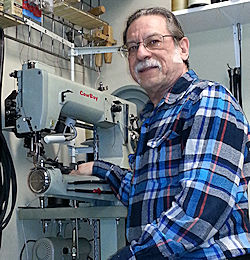
When it comes to sewing leather the best results are achieved with an industrial, compound feed walking foot sewing machine (e.g., upholstery sewing machines). The thicker the leather and heavier the thread, the bigger the machine must be. The largest leather sewing machines are called harness stitchers. These beasts are much heavier than standard upholstery sewing machines, having much stronger take-up cranks and levers and heavier tension and pressure springs.
Most people who buy the large harness stitchers, often called 441 clones (after the Juki TSC-441), use them to sew handgun holsters, knife sheathes, saddles, harnesses and saddle bags. These machines are able to sew at least 3/4 inch of veg-tan leather. They normally come preloaded with #277 bonded nylon thread, on top and in the bobbin and are adjusted and sewn off with this thread, with the test piece under the feet. Leatherworker.net has a forum dedicated to discussions about leather sewing machines. The most common brands and models discussed on Leatherworker.net include the Cowboy CB4500, the Cobra Class 4, and the Techsew 5100.
Nowadays, it seems that every leathercrafter who has worn out their hands with hand sewing their goods wants to buy that one sewing machine that does it all. They want it to sew wallet interiors, chaps, knife sheathes, tow straps, harnesses and extra thick gun holsters. I see them posting questions about which machine should I buy (to do all this), or similar wording. Respondents usually point out the fact that the typical upholstery grade walking foot sewing machines cannot sew thick holsters or use heavier thread than medium weight #138. The buyer will have to look at a more substantial machine, like a Cowboy, Cobra or Techsew, etc.
Most advice given is to buy more machine than you think you will need. So, the newbie to machine sewing shells out between $2000 to $3000 for a 441 clone (or $6000 for an actual Juki 441) expecting it to sew everything from wallet interiors to hand gun holsters. It sews the holsters just fine, but not the wallets or other thin projects. The knots are too big to hide between the thin leather layers. Pretty soon, they begin posting requests for help getting their (insert brand name and model) 441 super heavy duty stitcher to sew thin stuff. That's when they are told that they need to buy a lesser machine for thin work. Say what? I thought y'all said to buy more machine than I needed!
Some folks can and some can't afford to buy a second industrial sewing machine and table for thin work. Their other half (or they themselves) may own a domestic sewing machine, but they found it horrible at feeding and sewing leather, even wallets. They can't justify spending another thousand dollars for a lesser walking foot machine right now. What can they do if all they own is a 441 type machine? In these cases it is possible to "dumb down your machine" to get it to sew thin leather with thinner thread than it was built for. Here's how.
I'll use my Cowboy CB4500 as the reference, since that's what I currently own. Let's see how to dumb it down to sew thin stuff with thin thread.
Recent Comments